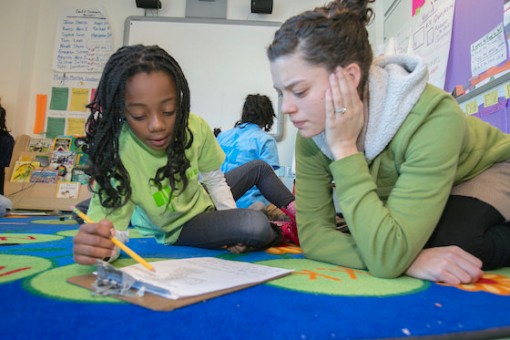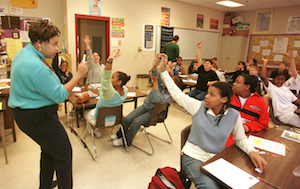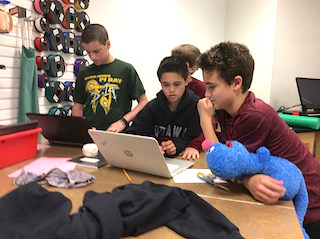17 Ideas to Help Combat Learned Helplessness
 By Sarah Tantillo
By Sarah Tantillo
Recently I’ve been thinking about the ways in which we either inculcate or prevent learned helplessness in students.
Some teaching practices help strengthen students’ self-efficacy, motivation and confidence, while others have the opposite effect. And the irony is that teachers might not even realize they are doing things that create this opposite effect.
Here’s some useful advice, sharing ways to deter “learned helplessness.” Some of what I suggest here is ELA-specific but much of it applies more generally to good classroom practice. I hope you find it useful in teacher observations and professional self-reflection. It zeroes in on problems, consequences, and solutions. (Download a Word version here.)
1. Don’t offer a “get out of work free” option
IF: You assign classwork and then go over it before holding students accountable for having completed it…
THEN: Students realize they can wait till the timer rings, then copy the answers as you go over them. So they don’t even try to do the work. They will sit quietly or chat with a neighbor, which is more fun.
SO DO THIS INSTEAD: Either circulate and assign credit (with a stamp or initial) as students work, collect it before reviewing, or provide and give credit for “notes from discussion” that students must complete in addition.
2. Make sure they’re invested
IF: You fail to make a pitch for the lesson’s objective…
THEN: Students will wonder, Why are we doing this? Being told WHAT they are doing (i.e., the agenda) is not enough. Without knowing the purpose for the lesson, students feel like hostages, and while they might comply with your demands, they are less likely to feel motivated or personally invested in the work.
SO DO THIS INSTEAD: Share the objective (which is ideally “RPM”—rigorous, purposeful, and measurable) and make a pitch that explains what’s in it for them. And remind them of that purpose throughout the lesson (“Let’s not forget WHY we’re looking for the most relevant evidence: so we can wow readers and convince them of our argument”).
3. Don’t skip modeling and guided practice
IF: You fail to model the work (esp. without interruption) and/or you skip guided practice…
THEN: Students will not work well independently. When students are unclear about what they are supposed to do, they do nothing. Or chat. Or do something else to get into trouble. Misbehavior is often the result of students feeling incompetent and acting out to distract from the fact that they don’t know how to be successful at what you are asking them to do.
SO DO THIS INSTEAD: Provide a clear, instructive model of whatever skills or strategies you want students to use. And remember, “I Do” doesn’t mean “I do everything while you sit silently and do nothing.” You need to engage students and check for understanding during the modeling phase so that you can assess if students need more modeling, paired work, or independent work.
4. Make sure they know what good looks like
IF: You don’t provide students with model essays, sentences, or examples BEFORE they need to complete a task…
THEN: They don’t know what “good” looks like and will be uncertain about what to do.
SO DO THIS INSTEAD: Analyze an exemplar before you set students to work. Assess it together on a rubric or compare “good” and “great” so students can aim for “great” from the start.
5. Prep students to apply generalized strategies
IF: You focus on the specific task/text/problem at hand without inviting students to apply a generalized skill/strategy…

SO DO THIS INSTEAD: Teach and name STRATEGIES, then remind students to use them when faced with challenges. Not “What should we do here?” but “What strategy should we use in a situation like this?” Provide clear steps for strategies. Prepare students to the point where, if you call out the name of a strategy, they immediately go into action.
6. Give them the skill sets and time to revise
IF: You provide written feedback to students with many details about grammar, diction, organization, etc., in isolation…
THEN: Students learn to depend on others to revise their work and can’t recognize their own mistakes.
SO DO THIS INSTEAD: Teach revision strategies (i.e., outlining their own essays to ensure coherence, classifying fragments and complete sentences, fixing run-on sentences, checking for consistent verb tense, etc.) and build in time for students to revise work – with your feedback on revisions.
7. Keep them on their learning toes
IF: You rarely use turn-and-talk and cold-calling…
THEN: Students recognize that only peers who raise their hands will get called on, so they can sit back and wait for others to do the work. Also, students who want to speak can become intimidated by those who tend to dominate the conversation.
SO DO THIS INSTEAD: Use purposeful turn-and-talk (and have students take notes sometimes) with cold-calling to increase engagement and accountability for performance. Find a way to randomize cold-calling (i.e., use note cards with student names that you shuffle through). Other times, plan your cold-call (choose a few who are typically middle-of-the-road in understanding, one high, and one struggling student).
8. Set the stage for cold-calling
IF: You cold-call without using stop-and-jot or turn-and-talk first…
THEN: Students feel put on the spot, are not held accountable, and are more inclined to opt out.
SO DO THIS INSTEAD: Give students a chance to think by writing something down and/or sharing with a partner before you cold-call.
9. You should teach hand-raising. Really.
IF: You ask questions during class discussions without modeling hand-raising…

SO DO THIS INSTEAD: Model hand-raising to ensure that students raise their hands to answer. Ensure you call on multiple students – or better yet, let students know the expectation is to call on another student when they are done to continue the discussion without you driving it!
10. Encourage students to try out their best answers
IF: You ask open-ended questions without adding, “There is more than one right answer”…
THEN: Students might believe there is ONE right answer, and they don’t know it for sure, so they will not take the risk of trying out a possible answer.
SO DO THIS INSTEAD: Say, “There is not one right answer” more often to invite students to take more risks and participate without fear of being wrong. [See note above about having students build on one another’s answers.]
11. Use your questioning to promote inference and explanation
IF: You ask students to guess what word you’re thinking of (which you think they should know)…
THEN: Students will call out random guesses until you give them enough hints to say the right word. Or they will say nothing because they don’t know what you’re talking about.
SO DO THIS INSTEAD: Stay away from guessing games like, “What word am I thinking of?” Tell them the word, tell them that you think it’s important, and ask them why you think that. Focus less on recall questions and more on using information/clues to infer and explain.
12. Make sure they wrestle with new learning
IF: You introduce new concepts or definitions by requiring students to copy down notes…
THEN: Students will not necessarily grasp or retain this information because they have not had to wrestle with it. Copying down definitions does not teach students how the concept works or how to use it. Telling is not teaching.
SO DO THIS INSTEAD: When introducing NEW content, give clear examples of the phenomenon (e.g., two bold-faced examples of “metaphor,” explained), then ask students to INFER from those examples what the phenomenon appears to be and how it seems to work. There is not one right answer.
13. Assigned reading should always have a purpose
IF: You assign reading with students without establishing a purpose for reading…
THEN: Students don’t know what they are supposed to look for or pay attention to. The default is NOTHING. So you can’t blame them if they stare out the window and think about lunch.
SO DO THIS INSTEAD: Clarify why you are reading this particular bit of text and what they are supposed to do while reading. Either provide a question or ask them to generate their own questions about the text.
14. Define the reading partnership
IF: You tell students to “read and work with a partner”…
THEN: You will see a lot of chatting and no reading. This is because students are unclear about their roles, so they wait for each other to take the lead, with the result that neither does. It’s easier to chat.

15. Don’t overdo the partnership work strategy
IF: You do ALL the work as a group or in partners…
THEN: Students learn they don’t need to do the hard work since it’s always done together and for them by others if they choose not to.
SO DO THIS INSTEAD: Plan and keep independent work time sacred in class with aggressive monitoring and personal feedback.
16. Stop sweeping in to save the day
IF: You answer student questions immediately during independent work time…
THEN: Students learn not to try or struggle on their own. They’ll always wait for you to swoop in!
SO DO THIS INSTEAD: Set a timer as soon as 100% of students are actually working and you have announced that you will address questions after 5 minutes of sustained work time. When the timer goes off, you can say, “Raise your hand if you need my attention,” and write student names on the board. Students then return to work and you address questions in the order of the names on the board so students aren’t sitting there waiting with their hands up.
17. Always encourage wonder
IF: You ask all the questions…
THEN: Students never learn to ask their own or invest themselves enough to wonder.
SO DO THIS INSTEAD: Create time for asking and answering questions about the text, problem, or content at hand. Invest students in seeking their own answers. Keep the wonder alive!
Thanks to Jessica Harrell at Great Oaks Legacy Charter School for contributing ideas used in this article.
________________
Sarah Tantillo is the author of The Literacy Cookbook (Jossey-Bass, 2012) and Literacy and the Common Core: Recipes for Action (Jossey-Bass, 2014). For more information, check out her website, The Literacy Cookbook, and her TLC Blog. You can read many other MiddleWeb articles by Sarah by clicking here.



































Excellent article with quick fixes to mistakes we can all fall into! Thank you.
Great list here. I would like to add that as we transition to CCSS math, modeling takes on a new meaning (students model with graphs, diagrams, and equations). In order to develop collaboration and deep thinking for that kind of modeling in my students, I began by substituting short discovery learning activities.that don’t require me to model. I am looking for contributions to that list: https://lanewalker2013.wordpress.com/2016/12/19/got-it-get-it-transfers/
I love this list! I think the current goings on with college “safe zones” and the need to teach “adulting” classes to military aged young people mean we have not successfully raised many to handle even slight discomfort. Your article is a breath of fresh air.
This is so healthy and clear. It is essential to confront learned helplessness. Racism feeds this by blaming ones failures on rich people or black peo or on white people Families and children can learn that blame is a way to sabatsge ones hope ones courage to ask for help ones self esteem YES there are unspoken barriers They are real However we need to not empower them
Happy to be of use!
What are some strategies to use at home?
Fantastic article! Positive, possible and practical.
Learned helplessness occurs when an animal/human struggles for too long to escape a painful experience, only to realize that there IS no escape so they give up and learn other techniques to just cope with the pain. Then, when the limitations are removed (like, say, graduation), they”forget” how to try to escape their pain. Now they are free to walk away, but continue to lie down and endure the pain bc the brain has been coded to stop trying, it now feels there is no possibility of escape even when there is. So they stay miserable rather than pursuing freedom from misery.
This list is concrete and specific in how to shift teacher instruction and strategies in the middle school classroom. I especially connected with #16. Stop Sweeping In to Save the Day. The strategy to promote 100% engaged student work time for a minimum of five minutes before answering questions is a strategy I am going to try during our revisions for our argumentative writing papers.
I provide teacher feedback and time for revisions, and many students come to me immediately to ask how to fix their writing correctly without attempting it on their own. Thanks for sharing so many wonderful suggestions that are specific and realistic to create shift in our classroom culture quickly!